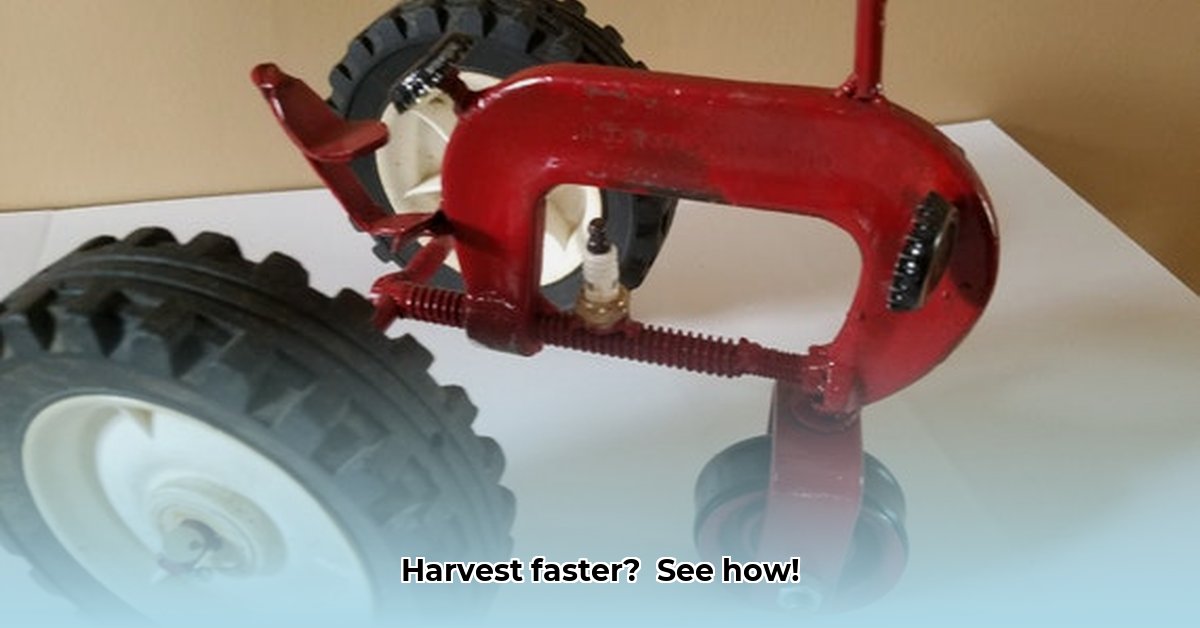
Tractor Clamps: Revolutionizing Harvesting Speed and Efficiency
Tractor clamps, also known as clamp-on trailer hitch receivers, are transforming agricultural practices by significantly speeding up equipment changes. This translates to increased productivity, reduced labor costs, and ultimately, a more profitable farming operation. But how do they work, and are they the right investment for your farm? This comprehensive guide will answer these questions and provide practical advice for maximizing their benefits. For more information on tractor attachments, see this helpful guide.
Understanding Tractor Clamps: A Quick-Connect Solution
Tractor clamps function as quick-connect systems, enabling rapid attachment and detachment of implements like plows, seeders, and harvesters. Unlike traditional pin-and-linkage systems, which can be time-consuming and potentially hazardous, tractor clamps allow for equipment changes in mere minutes. This efficiency gain directly impacts your farm's overall productivity.
"The time saved switching implements is invaluable," says Dr. Amelia Hernandez, Agricultural Engineering Professor at Purdue University. "It's not just about the minutes saved; it's about the cumulative effect on daily output and overall farm efficiency."
How Tractor Clamps Boost Farm Efficiency
The primary benefit of tractor clamps is their time-saving capability. This efficiency increase manifests in several ways:
- Reduced Labor Costs: Faster equipment changes minimize the need for additional labor, directly reducing your payroll expenses.
- Increased Yields: More time spent actively harvesting translates to a larger harvested area and consequently, higher yields. Isn't maximizing your harvest a key goal for any farmer?
- Improved Farm Management: Streamlined operations free up valuable time for strategic planning, crop monitoring, and proactive farm management. This allows farmers to focus on long-term sustainability and profitability.
Choosing the Right Tractor Clamp: A Practical Buying Guide
Selecting the appropriate tractor clamp requires careful consideration of several factors:
Compatibility: Ensure complete compatibility with your tractor model and all the implements you intend to use. Incorrect compatibility can lead to unsafe operation.
Weight Capacity: Always choose a clamp with a weight capacity exceeding the heaviest implement you'll be using. Overloading a clamp compromises safety and can cause equipment damage.
Durability: Invest in a clamp constructed from high-quality, durable materials capable of withstanding the demanding conditions of farm work. Look for clamps with robust construction and corrosion-resistant finishes.
Safety Features: Prioritize safety features such as clearly marked weight limits, secure locking mechanisms, and easy-to-understand instructions.
Safe Operation of Tractor Clamps: Prioritizing Safety
Safe operation is paramount. Always adhere to these safety practices:
Correct Attachment: Follow the manufacturer's instructions precisely. Incorrect attachment is a significant safety hazard.
Regular Inspection: Conduct regular inspections for any signs of wear, tear, or damage. Address any issues promptly.
Operator Training: Ensure all operators receive comprehensive training on the safe and correct use of tractor clamps.
The Future of Tractor Clamps: Technological Advancements
The agricultural industry is actively pursuing standardization of tractor clamps to enhance interoperability between different brands. Furthermore, research into automated attachment systems holds the promise of even greater efficiency gains in the future. This ongoing technological development signifies significant advancements toward more streamlined and efficient farming operations.
Tractor Clamps: A Comparative Analysis
| Feature | Clamp-on Hitches | Integrated Hitch Systems |
|---|---|---|
| Cost | Generally lower initial investment | Higher initial investment |
| Installation | Relatively easy and quick | More complex installation |
| Stability | Can be less stable; prone to rattle | Generally more stable and secure |
| Versatility | Wide range of compatibility | Often more limited compatibility |
| Maintenance | Minimal maintenance requirements | Might require more frequent maintenance |
Is a Tractor Clamp Right for Your Farm?
The suitability of tractor clamps depends on your specific needs and farm size. Weigh the pros and cons carefully. However, if efficiency, productivity, and reduced labor costs are priorities, then tractor clamps are definitely worth considering.
How to Choose the Best Clamp-on Trailer Hitch Receiver for Sustainable Farming
Choosing the correct trailer hitch receiver is crucial for efficient and sustainable farming practices. The selection process should account for your farm's specific needs, budget constraints, and longer-term sustainability goals.
Evaluating Your Farming Operation
Before making a purchase, thoroughly evaluate your farm's operations. Consider the types of trailers and implements used, the frequency of equipment changes, and the typical terrain conditions. These factors influence the type of hitch system best suited to your farm.
Clamp-on vs. Integrated Hitch Systems: A Detailed Comparison
Clamp-on hitches offer a budget-friendly solution with easy installation. However, their stability can be compromised, potentially leading to safety issues and equipment damage. Integrated systems, while more expensive, provide significantly enhanced stability and durability, making them a more suitable long-term investment.
Key Considerations:
Budget: Balance initial costs with anticipated long-term savings in labor and efficiency.
Frequency of Use: Frequent equipment changes necessitate a more robust and stable hitch system.
Load Capacity: The hitch's load capacity must exceed the weight of the heaviest trailer or implement.
Safety: Proper maintenance and regular inspections are essential for sustained safety.
Sustainable Practices Beyond Hitch Selection
Choosing the right hitch receiver is just one component of sustainable farming. Complement this choice with other sustainable practices, such as route optimization for fuel efficiency and proactive equipment maintenance to extend its lifespan. By integrating sustainable practices across your entire operation, you can improve environmental impact and long-term farm viability.